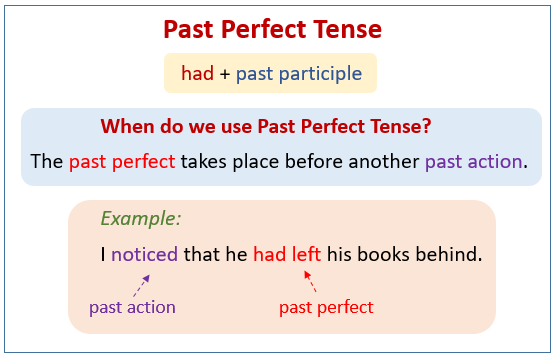Past Perfect Tense
In these lessons, we will learn
- how to form the past perfect tense
- when to use the past perfect tense
- how to form negatives in the past perfect tense
- the differences between the present perfect tense, past perfect tense and future perfect tense
Related Pages
Present Perfect Tense
Simple Past Tense
Past Participle
IELTS, TOEFL And English As A Second Language
More Lessons On English Grammar
Verbs have different forms, called tenses. The tense of a verb tells us when the action happens.
The following diagram shows how to use the Past Perfect Tense. Scroll down the page for more examples of how to use the past perfect tense.

Forming the Past Perfect Tense
The past perfect consists of two verbs: helping verb (had) and main verb (past participle).
had + past participle = past perfect tense
When to use the Past Perfect?
The past perfect takes place before another past action.
Examples:
Suddenly he remembered where he had hidden the money. (past action – remembered, past perfect – had hidden)
I noticed that he had left his books behind. (past action – noticed, past perfect – had left)
When he reached the bus stop, the bus had already left. (past action – reached, past perfect – had left)
Negatives in the Past Perfect Tense
We form the negative by adding not after the helping verb had.
had + not + past participle
Contraction (or short form):
had not = hadn’t
Examples:
The clock struck eleven, and he still had not gotten out of bed.
We hadn’t been at the party long when Jack arrived.
Differences between the present perfect tense, past perfect tense and future perfect tense
| Tense | Form |
| present perfect tense | has/have + past participle |
| past perfect tense | had + past participle |
| future perfect tense | will have + past participle |
The present perfect tense connects the past with present.
The past perfect tense takes place before another action in the past.
The future perfect tense takes place before another action in the future.
Example:
Since last Tuesday, I have woken up early. (present past tense)
Before this week, however, I had never woken up so early. (past perfect tense)
By the end of this week I will have woken up early four times. (future perfect tense)
The following video shows how to make the past perfect tense: had + past participle. The past perfect shows that something happened before another past event.
The following video examines the use of perfect tenses in both the simple and continuous aspect - past, present and future forms. In grammatical terms, perfect tenses are used to refer to completed or finished events.
In this grammar lesson, you’ll learn when and how to use the past perfect.
Try out our new and fun Fraction Concoction Game.
Add and subtract fractions to make exciting fraction concoctions following a recipe. There are four levels of difficulty: Easy, medium, hard and insane. Practice the basics of fraction addition and subtraction or challenge yourself with the insane level.

We welcome your feedback, comments and questions about this site or page. Please submit your feedback or enquiries via our Feedback page.